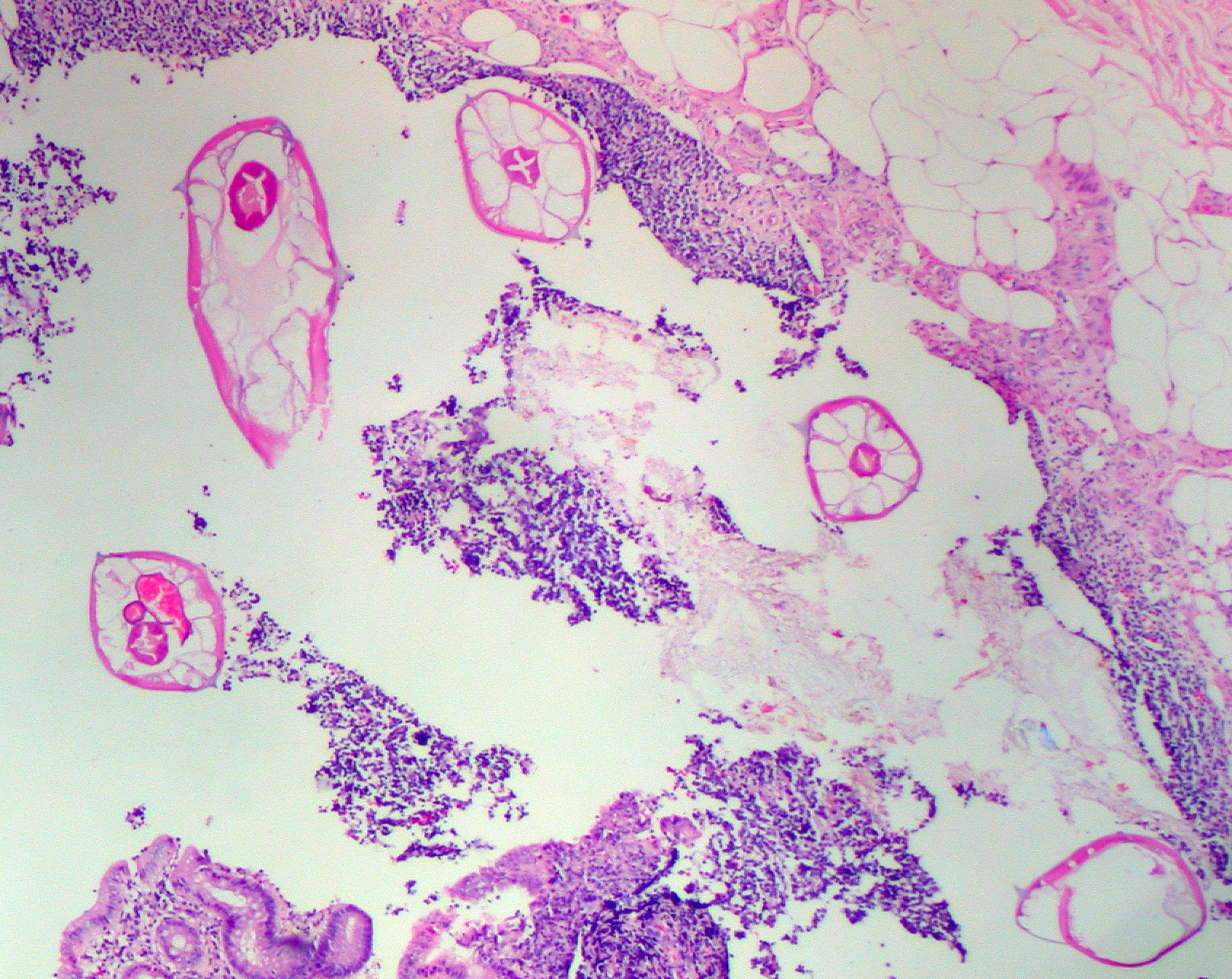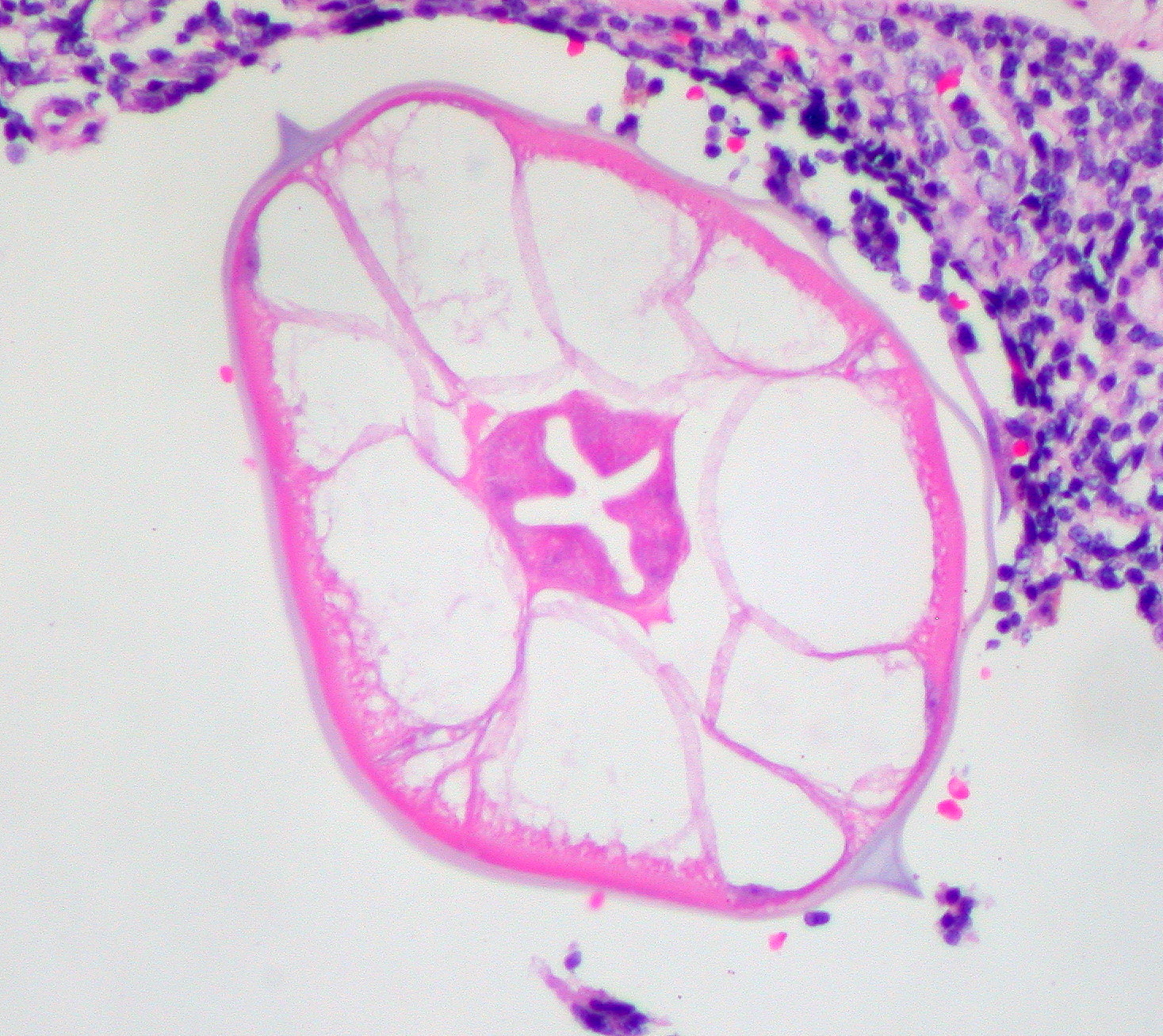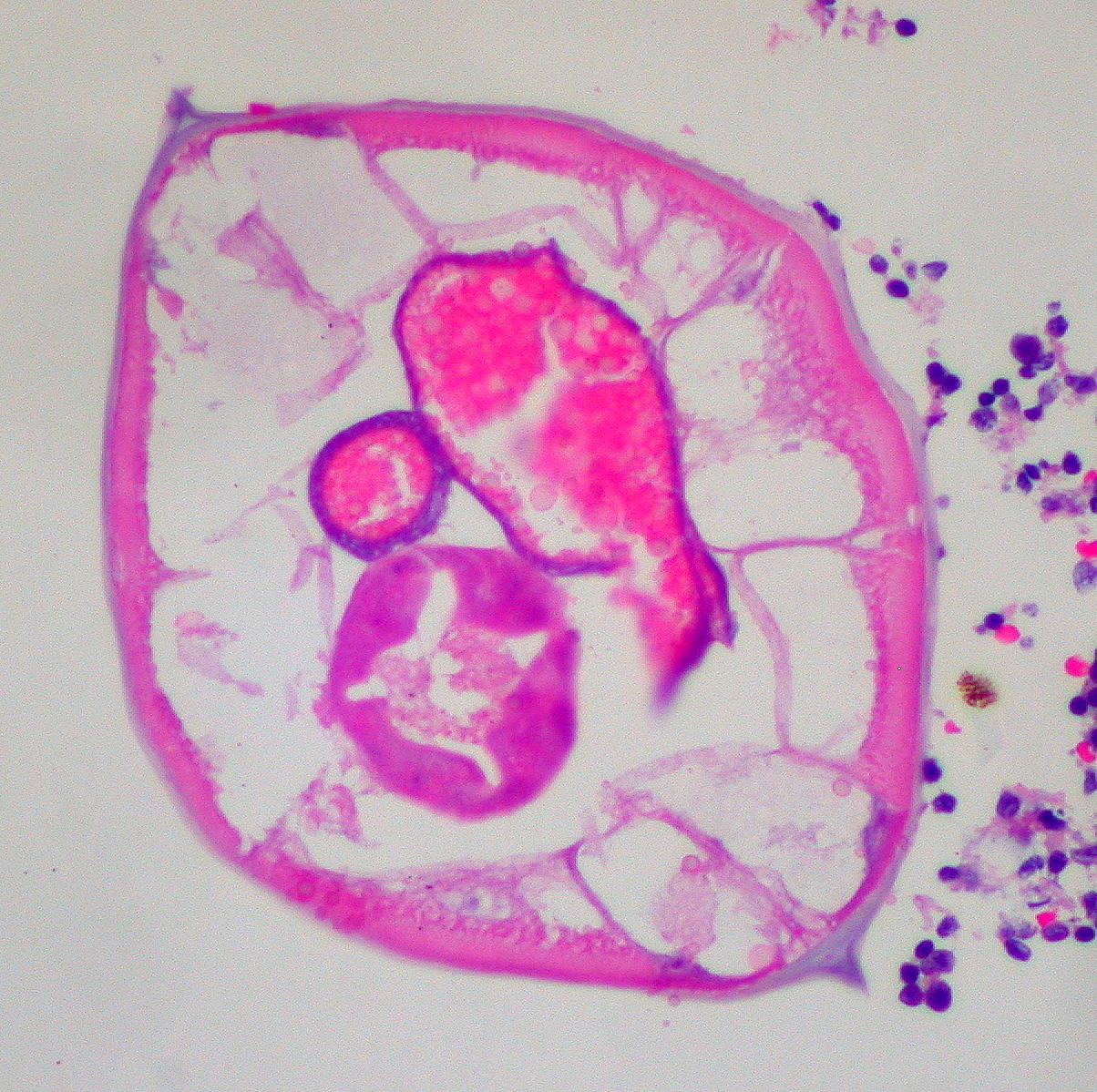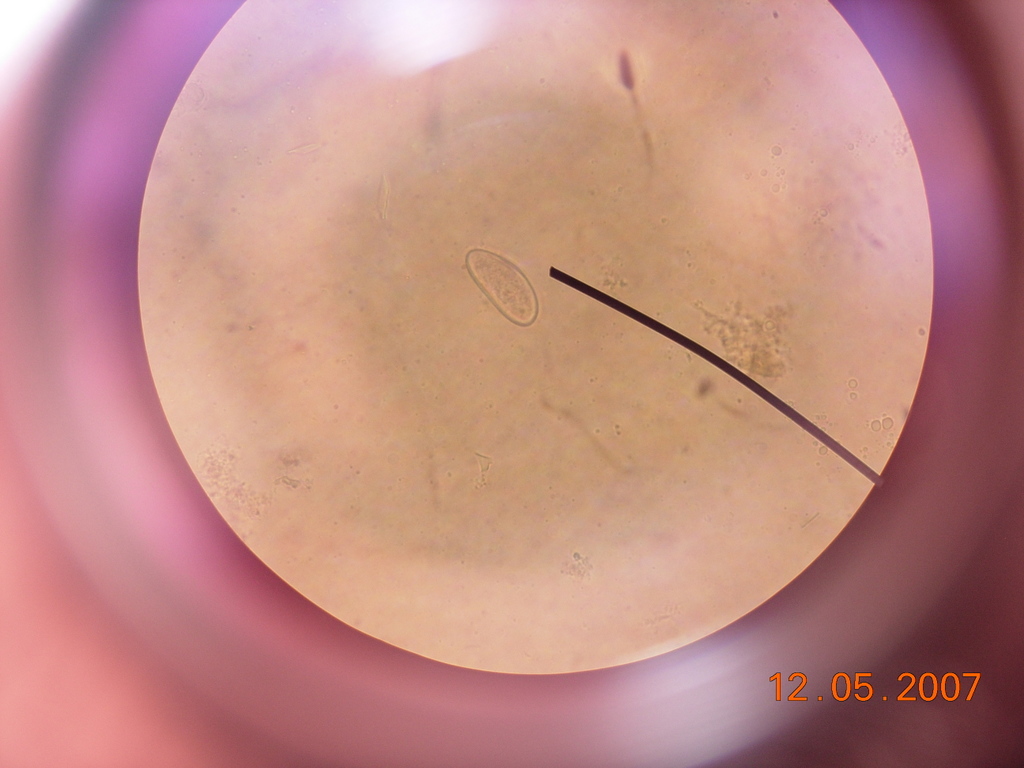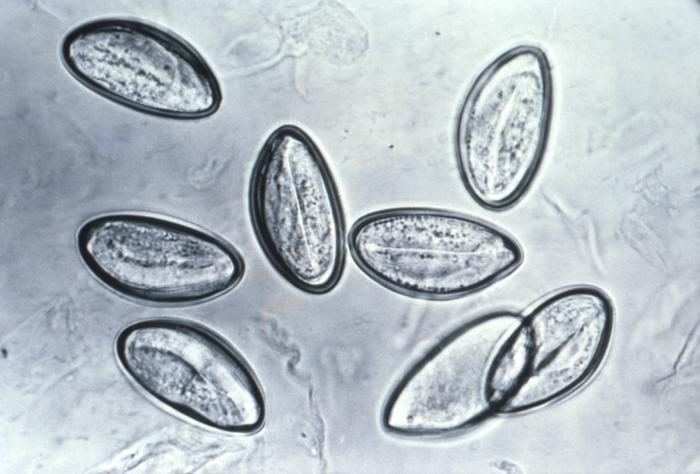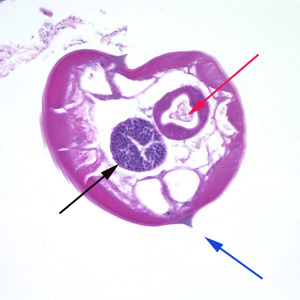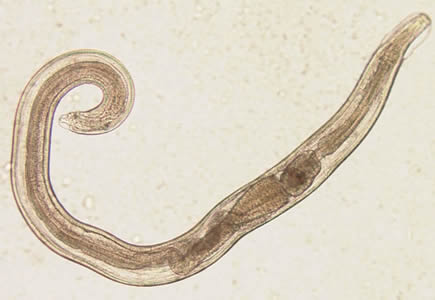Pinworm
| Pinworm
ICD 127.4 | ||||||||||||
|---|---|---|---|---|---|---|---|---|---|---|---|---|
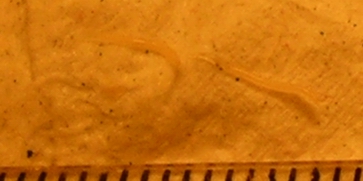 Two pinworms, captured on emergence from the anus. Markings are 1 mm apart
| ||||||||||||
| Scientific classification | ||||||||||||
| ||||||||||||
| Species | ||||||||||||
|
Enterobius vermicularis |
|
WikiDoc Resources for Pinworm |
|
Articles |
|---|
|
Most recent articles on Pinworm |
|
Media |
|
Evidence Based Medicine |
|
Clinical Trials |
|
Ongoing Trials on Pinworm at Clinical Trials.gov Clinical Trials on Pinworm at Google
|
|
Guidelines / Policies / Govt |
|
US National Guidelines Clearinghouse on Pinworm
|
|
Books |
|
News |
|
Commentary |
|
Definitions |
|
Patient Resources / Community |
|
Directions to Hospitals Treating Pinworm Risk calculators and risk factors for Pinworm
|
|
Healthcare Provider Resources |
|
Causes & Risk Factors for Pinworm |
|
Continuing Medical Education (CME) |
|
International |
|
|
|
Business |
|
Experimental / Informatics |
Editor-In-Chief: C. Michael Gibson, M.S., M.D. [1]
Overview
The pinworm (Genus Enterobius) is a parasitic roundworm of the phylum Nematoda.
Forms of worm
The best known is the human pinworm Enterobius vermicularis and the more recently discovered Enterobius gregorii. The adult pinworm male is 1–4 mm in length, while the adult female is 8–13 mm and possesses the long, pin-shaped posterior for which the worm is named. The human pinworm is commonly found in children, but adults may also be affected.
Habitat
The pinworm lives in the large intestine and cecum. It is found worldwide, and causes the most common infection enterobiasis in humans. Unlike many other intestinal parasites, the pinworm does not usually enter the bloodstream or any other organs besides the intestines. Only in rare cases pinworms are found in the vagina, and even more rarely in the uterus, fallopian tubes, liver, and peritoneum, but the worms cannot survive long in these places.
The human pinworm Enterobius vermicularis is a ubiquitous parasite of man, it being estimated that over 200 million people are infected annually. It is more common in the temperate regions of Western Europe and North America, (it being relatively rare in the tropics) and is found particularly in children. Samples of Caucasian children in the U.S.A. and Canada have shown incidences of infection of between 30% to 80%, with similar levels in Europe.[1]
Reproduction
After mating, the male dies. The female migrates to the anus and emerges, usually during the night, to deposit about 10,000 to 20,000 eggs in the perianal area (around the anus). She then secretes a substance which causes a very strong itching sensation, inciting the host to scratch the area and thus transfer some of the eggs to the fingers. Eggs can also be transferred to cloth, toys, and the bathtub. Once ingested orally, the larvae hatch in the small intestine specifically the duodenum and migrate back to the large intestine where they mature, maturity is reached in 30-45 days. The eggs can survive for 2 to 3 weeks on their own outside of the human body. In some cases, the larvae will hatch in the peri-anal area and travel back inside the anus, up the rectum, and back into the intestines where they mature.[2]
Effects
Except for itching, pinworm infestation does not usually cause any damage to the body. Sleep disturbance may arise from the itching or crawling sensations. Some case reports suggest that severe infestation may be associated with an increased risk for appendicitis. There is also some evidence of an association between enterobiasis and diminished zinc levels.
Diagnosis
Diagnosis is often made clinically by observing the female worm (or many worms) in the peri-anal region, but can also be made using the "scotch-tape" test, in which the sticky side of a strip of cellophane tape is pressed against the peri-anal skin, then examined under a microscope for pinworm eggs.
The actual worms may be seen in the host's faeces; however the eggs are invisible to the naked eye.
The diagnostic characteristics are: size 50-60 µm by 20-32 µm; typical elongated shape, with one convex side and one flattened side and colorless shell [3].
On histologic cross-section, alae or wings (running the length of the worm) are identifying features of the pinworm (see micrograph).[4]
Appendix: Pinworms
<youtube v=PkemlmA_tf0/>
Additional images
-
Two pinworms, captured on emergence from the anus. Markings are 1 mm apart.
-
Pinworms are sometimes diagnosed incidentally by pathology. Micrograph of pinworms in the appendix. H&E stain.
-
High magnification micrograph of a pinworm in cross-section in the appendix. H&E stain.
-
High magnification micrograph of a pinworm in cross-section in the appendix. H&E stain.
-
Enterobius vermicularis egg under a light microscope.
-
Pinworm eggs are easily seen under a microscope.
-
Pinworms are sometimes diagnosed incidentally by pathology. Micrograph of male pinworm in cross-section. Alae (blue arrow), intestine (red arrow) and testis (black arrow). H&E stain.
-
A pinworm (Enterobius vermicularis).
Treatment
Anti-pinworm drugs such as Albenza (albendazole), Vermox (mebendazole), or Pin-X (pyrantel pamoate) are commonly used to treat pinworms. It is not a necessity to visit a doctor to get these drugs, as Pin-X is available as an over the counter medication (Albenza and Vermox are prescription in the US); ask a pharmacist for medicines to treat pinworms (or threadworms as they are known in the UK). These medicines kill the pinworms 95% of the time, but do not kill the eggs. The person being treated may have to return after a time of two weeks to be re-treated. Another precaution is to wash the hands before eating (to prevent any pinworm eggs under fingernails from being ingested) and to wash any area or clothes that have touched or been in the vicinity of the infected areas. Treating the entire family is often necessary for cure.
References
- ↑ The Human Pinworm
- ↑ Rudolph's Pediatrics - 21st Ed. 2003; Current Medical Diagnosis & Treatment - 45th Ed. 2006
- ↑ "PARASITOLOGY - CHAPTER FOUR NEMATODES (Round Worms)". The Board of Trustees of the University of South Carolina. Retrieved 2007-10-18.
- ↑ Diagnostic Findings Enterobiasis. Centers for Disease Control and Prevention. URL: http://www.dpd.cdc.gov/dpdx/HTML/Enterobiasis.htm. Accessed on: August 6, 2008.
External links
External Links
- New England Journal of Medicine Video. A 55-year-old man presented with intermittent, crampy pain in the right lower quadrant of the abdomen. A colonoscopy was ordered and revealed multiple mobile 1-cm worms, Enterobius vermicularis, in the cecum.
- The Human Pinworm: The human pinworm Enterobius vermicularis is a ubiquitous parasite of man, it being estimated that over 200 million people are infected annually. It is more common in the temperate regions of Western Europe and North America, (it being relatively rare in the tropics) and is found particularly in children. Samples of Caucasian children in the U.S.A. and Canada have shown incidences of infection of between 30% to 80%, with similar levels in Europe.
bg:Острица (животно)
da:Børneorm
de:Madenwurm
fi:Kihomato
id:Cacing kremi
is:Njálgur
ka:ენტერობიუსი
ko:요충
nl:Aarsmade
no:Barnemark
sl:Podančica
sv:Springmask
zh-yue:蟯蟲
